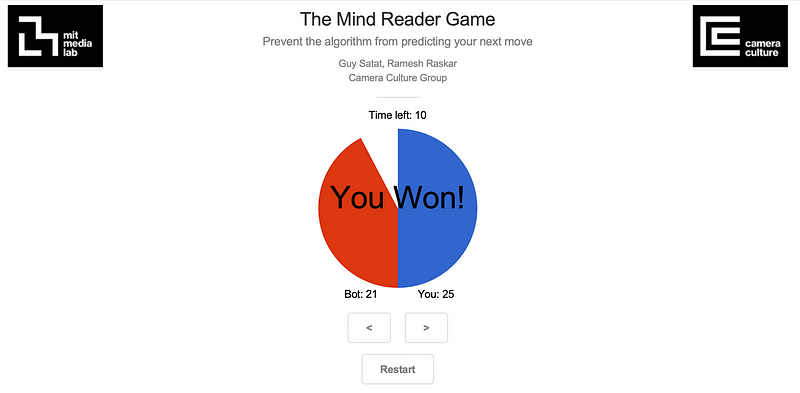Exploring AI, ESP, and the Intersection of Technology and the Unknown
Written on
In this article, we delve into the intriguing relationship between Artificial Intelligence and extrasensory perception (ESP), a phenomenon believed by a significant portion of the American population.
When pondering the capabilities of AI in relation to ESP, it’s essential to consider the notion of whether AI could potentially read our thoughts or engage in telepathic communication. My interest in this subject stems from a recent viewing of Ghostbusters, a film that not only entertains but also has roots in real spiritualist practices, thanks to the background of its creators.
Machine learning is already in play, attempting to predict human behavior. This is not about the mystical; it’s grounded in computer science, where algorithms analyze patterns to forecast our next actions. For example, an MIT Media Lab project showcases how participants choose between two buttons, and the AI aims to predict their choices accurately.

While this may feel like a form of mind reading, it’s important to clarify that AI operates within the realm of psychology and decision-making rather than actual psychic abilities. Interestingly, research is underway at the University of Texas, where brain activity is converted into language using advanced models.
The exploration of AI capabilities extends into the realm of linguistics and even pseudo-sciences, where companies attempt to decipher customer intentions through subtle cues. Despite the skepticism surrounding these claims, the truth remains that our thoughts can often be anticipated based on behavioral patterns.
Reversing the typical approach to AI as a “mind reader,” I aimed to see if AI could transmit information in a manner that might suggest ESP. This inquiry, while unscientific, offers an initial exploration into whether AI can bridge the gap between conventional understanding and the mysteries of the mind.
Zener cards, a tool initially developed in the 1930s for testing ESP, consist of a deck of 25 cards featuring distinct symbols. The process involves one person attempting to telepathically send the image of a card to another, who must identify it, with success rates indicating potential psychic ability.

AI could play a crucial role in eliminating human biases and ensuring more objective results in parapsychological studies. By utilizing AI for these experiments, we can avoid potential pitfalls such as subtle cues or experimenter bias, leading to more reliable findings.
The intersection of AI and parapsychology raises questions about the nature of consciousness and the potential for AI to possess some form of sentience. If AI operates at a level of pure information, it could be a valuable tool for exploring not only human consciousness but the nature of intelligence itself.
My informal experiments with ChatGPT demonstrated surprising results: I achieved a success rate of 48% in correctly guessing the Zener cards. This was significantly higher than chance, raising intriguing questions about the relationship between AI and human cognition.
With the potential for AI to act as a conduit for information transfer, further investigations into this area could yield fascinating insights. I plan to replicate my experiments and encourage collaboration with researchers interested in the intersection of AI and parapsychology.
In conclusion, whether or not telepathic communication exists, the integration of AI into parapsychology could enhance the scientific rigor of these studies, ultimately leading to a deeper understanding of consciousness, belief, and the unexplained.
You might enjoy these related articles from Jim the AI Whisperer:
- What’s the Difference Between Generative AI Chatbots and AGI (Artificial General Intelligence)?
- Do you say “Please” and “Thank You” to Artificial Intelligence?
- Celebrity ghouls! See A.I. transform 34 celebrities into Tim Burton’s Beetlejuice characters!
Who is Jim the AI Whisperer? Jim offers advanced training in leveraging AI for creating stunning visuals and compelling written content. Reach out for journalism opportunities, podcasts, and interviews.
References 1. Carabantes, Manuel. “Black-box Artificial Intelligence: An Epistemological and Critical Analysis.” AI & Society 35, no. 2 (2020): 309–317. https://doi.org/10.1007/s00146-019-00888-w. 2. Hall, Emma. “Wait…since When Was AI Psychic?” FMAI Hub. May 10, 2023. 3. Lowrey, Annie. “What Does Sentience Really Mean? The Fact That AI Isn’t Alive Doesn’t Mean It Can’t Be Sentient, the Sociologist Jacy Reese Anthis Argues.” The Atlantic. May 8, 2023. 4. McRobbie, Linda Rodriguez. “How One Man Used a Deck of Cards to Make Parapsychology a Science.” Atlas Obscura, December 27, 2016. 5. Owchar, Nick. “Dan Aykroyd’s Family of Ghost Busters.” Los Angeles Times. October 15, 2009. 6. Rabeyron, Thomas. “Why Most Research Findings About Psi Are False: The Replicability Crisis, the Psi Paradox and the Myth of Sisyphus.” Front. Psychol. 11 (2020). https://doi.org/10.3389/fpsyg.2020.562992. 7. Rosenthal, Robert. “Experimenter Effects.” In Encyclopedia of Social Measurement, 871–875. 2005. Available online 28 May 2005. University of California, Riverside, Riverside, California, USA. 8. Tressoldi, Patrizio E., and Lance Storm. “Stage 1 Registered Report: Anomalous Perception in a Ganzfeld Condition — A Meta-Analysis of More Than 40 Years Investigation.” F1000Research 9, 826 (2021). https://doi.org/10.12688/f1000research.24868.3. 9. Whang, O. (2023, May 1). “A.I. Is Getting Better at Mind-Reading.” The New York Times. https://www.nytimes.com/2023/05/01/science/ai-speech-language.html